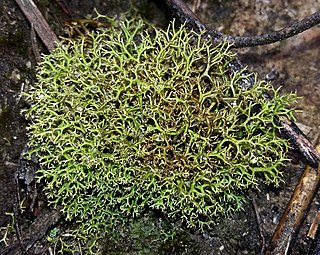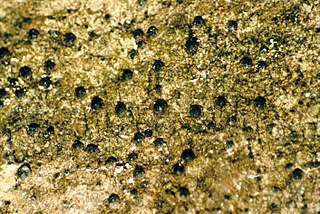
Ochrolechia is a genus of crustose lichens in the family Ochrolechiaceae.

Cladia is a genus of lichenized fungi in the family Cladoniaceae. Cladia species have a crustose primary thallus and a fruticose, secondary thallus, often referred to as pseudopodetium. The type species of the genus, Cladia aggregata, is widely distributed, occurring from South America, South Africa, Australasia and South-East Asia to southern Japan and India. Most of the other species are found in the Southern Hemisphere.
Kantvilasia is a lichen genus in the family Pilocarpaceae. This is a monotypic genus, containing the single species Kantvilasia hians.

Gassicurtia is a genus of lichenized fungi in the family Caliciaceae.

Lecidella is a genus of crustose lichens in the family Lecanoraceae.

Rhizocarpon is a genus of crustose, saxicolous, lecideoid lichens in the family Rhizocarpaceae. The genus is common in arctic-alpine environments, but also occurs throughout temperate, subtropical, and even tropical regions. They are commonly known as map lichens because of the prothallus forming border-like bands between colonies in some species, like the common map lichen.

The Tephromelataceae are a family of lichenized fungi in the order Lecanorales. The family was circumscribed by Austrian lichenologist Josef Hafellner in 1984. Tephromelataceae comprises the genera Tephromela, Calvitimela, Mycoblastus and Violella, which together constitute a well-supported monophyletic group.

Hertelidea is a genus of crustose lichens in the family Stereocaulaceae. Characteristics of the genus include carbon-black ring or outer margin (exciple) around the fruit body disc (apothecium), eight-spored, Micarea-type asci and mostly simple, hyaline ascospores that lack a transparent outer layer. Hertelidea species mostly grow on wood, although less frequently they are found on bark or soil. While the type species, Hertelidea botryosa, has a widespread distribution, most of the other species are found only in Australia.
Gintaras Kantvilas is an Australian lichenologist, who earned his Ph.D in 1985 from the University of Tasmania with a thesis entitled Studies on Tasmanian rainforest lichens. He has authored over 432 species names, and 167 genera in the field of mycology.
Amandinea devilliersiana is a species of crustose lichen in the family Caliciaceae, and found in South Australia. It was first described in 2013 by Australian lichenologists Jack Elix and Gintaras Kantvilas from a specimen collected on a granite boulder near the seashore in South Australia. The species epithet, devilliersiana, honours Brigitte de Villiers. Specimens used for the description came from both Tasmania and South Australia.

Scoliciosporum is a genus of lichens in the family Scoliciosporaceae.

Solenopsora is a genus of lichen-forming fungi in the family Catillariaceae. It has 15 species, with a mostly Northern Hemisphere distribution.

Schaereria is a genus of lichen-forming fungi. It is the sole genus in the family Schaereriaceae, which itself is the only family in the Schaereriales, an order in the subclass Ostropomycetidae of the class Lecanoromycetes. Most Schaereria species are crustose lichens that live on rocks. Schaereria was first proposed by Gustav Wilhelm Körber in 1855 and was later taken up by other lichenologists despite periods of disuse.
Australidea is a genus in the family Malmideaceae. It is monospecific, containing a single species, the crustose lichen Australidea canorufescens. The genus was circumscribed by Gintaras Kantvilas, Mats Wedin, and Måns Svensson in 2021 to contain the species previously known as Lecidea canorufescens. This lichen is widespread in temperate Australia.

Megalospora is a genus of lichen-forming fungi in the family Megalosporaceae.
Ramboldia blastidiata is a species of saxicolous (rock-dwelling) and crustose lichen in the family Lecanoraceae. Found in Australia, it was formally described as a new species in 2007 by lichenologists Gintaras Kantvilas and John Elix. The type specimen was collected by the first author from the western slopes of Strzelecki Peaks on Flinders Island (Tasmania) at an altitude of 150 m (490 ft); here, in dry sclerophyll forest, it was found growing on a granite boulder. The lichen forms pale grey-green, olive-green to dull olive-brown crust-like patches up to 30 cm (12 in) wide. The authors suggest that it is widespread in temperate Australia and Tasmania, but not commonly collected. Others saxicolous lichens that it usually grows with include Ramboldia petraeoides, Lecanora farinacea, Xanthoparmelia mougeotina, and species from the genera Buellia and Rhizocarpon. The specific epithet blastidiata refers to the presence of blastidia, which are vegetative propagules that contain mycobiont and photobiont and are produced by yeast-like budding.
Angiactis is a genus of crustose lichens of uncertain familial placement in the order Arthoniales. It has four species.
Cameronia is a genus of crustose lichens in the monotypic family Cameroniaceae. It has two species. Both the genus and its two species were described as new to science in 2011 by Australian lichenologist Gintaras Kantvilas. Characteristics of the genus include its chlorococcalean photobiont partner, and perithecioid ascomata that are deeply immersed in the substrate. Microscopic features of Cameronia include the four-spored asci with an intensely hemiamyloid outer wall and non-amyloid, well-developed tholus, and hyaline, muriform ascospores. Both species are endemic to the Tasmanian Highlands.
Austrographa is a genus of lichen-forming fungi in the family Roccellaceae. It has three species. The genus was circumscribed in 2013 by lichenologists Laurens Sparrius, John Elix, and Alan Archer, with Austrographa kurriminensis assigned as the type species. The genus had been published invalidly on two separate occasions. All three species in the genus were found in a mangrove stand in Queensland, Australia. The genus was discovered in Australia, and the name Austrographa reflects this.
Coenogonium australiense is a species of corticolous (bark-dwelling), crustose lichen in the family Coenogoniaceae. Found in Australia, it was formally described as a new species in 2018 by lichenologists Gintaras Kantvilas and Robert Lücking. The type specimen was collected by the first author near Little Fisher River (Tasmania) at an altitude of 880 m (2,890 ft), where it was found in a rainforest growing on Nothofagus cunninghamii. The species epithet australiense refers to its geographical distribution. In addition to Tasmania, the lichen has also been documented from New South Wales and Kangaroo Island. In the latter location it was found in remnant stands of coniferous woodland, where it was growing on the bark of old, fissured Callitris trunks.











